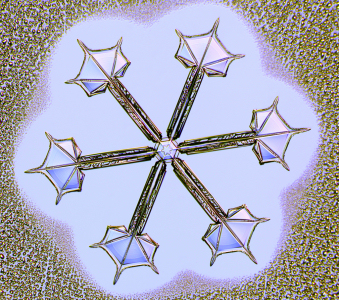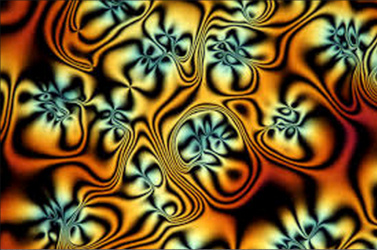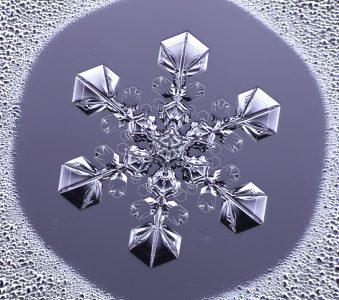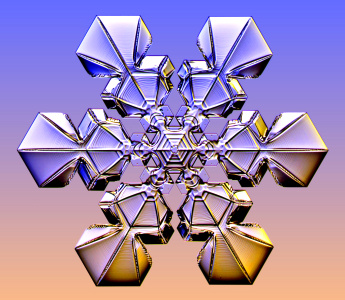|
|
 Curiosity-Driven
Research Curiosity-Driven
Research
People often ask me about practical applications of my research into
snow crystals. For example, what applications might come out of making Designer
Snowflakes like the one on the left? Sometimes the questions
are more direct -- why are you doing this, and what's it good for?
My study of snowflake science is an example of what
is called curiosity-driven
research, motivated by a basic desire to understand how
things work. Snow crystals simply fall out of the sky with these
amazing patterns and structures, and modern science still cannot
explain their formation in detail. With more than seven billion people
on the planet, I figure a few of us can be spared to look into these
matters.
I also like to quickly add that none of your tax dollars are being used
for this research. Instead I spend the revenue generated from my Snowflake
Books. (Please take a look; they make excellent gifts!)
Fortunately, growing laboratory snowflakes does not require enormous
resources. Sometimes I get some help from interested summer students,
but mostly it's just me poking around in the lab. I think of it all as
something of a scientific hobby. |
|
 The Long View The Long View
People often underestimate the importance of curiosity-driven research,
simply because they are not taking the long view. For example, in the
1920s chemists spent quite a bit of time researching some odd-looking
compounds that came to be called liquid
crystals.
They were liquids, but they looked bizarre in polarized light (the
image on the right), and this puzzled scientists. Over time, the
puzzles were solved, and the odd properties of these materials were
explained. But, in the 1920s, no one said, "... and these liquid crystals
have great potential for making flat-screen television
displays someday." It
was many decades before liquid crystals were anything
more than laboratory curiosities. But eventually liquid crystals
became, and still are, at the center of a multi-billion-dollar industry.
Essentially all the technological
advances we now enjoy have their intellectual roots in people tinkering
in the lab, or scribbling on paper, just trying to figure out how
things work. You just have to take the long view of science and
technology.
By figuring out how ice crystals grow, one learns about
crystal growth in general. And this tells us about the detailed molecular
dynamics of crystalline surfaces. Eventually this may help produce
better industrial crystals (semiconductors, diamonds, lasers) and
perhaps advanced materials no one has yet imagined. There is no telling
what might come out of curiosity-driven research, even the science of snowflakes! |
|
 A Continuing
Scientific Journey A Continuing
Scientific Journey
One of the fun aspects of snowflake science is that it has been an ongoing enterprise for a very long time (see A
Brief History of Snowflakes).
After all, these fascinating structures appear, quite literally, out of
thin air, crying out for an explanation. Progress has been slow, but
steady.
The snowflake's six-fold symmetry was explained in the
early 20th century, when X-ray crystallography revealed the hexagonal
structure of the ice lattice, and crystal faceting was worked out in detail in the 1950s. Dendritic branching
was solved (for non-facet branching) in the 1980s, and the faceted
branching see in snowflakes was first demonstrated on the computer in
2005. The edge-sharpening instability was only discovered a few years ago, and is still not well understood. The morphology diagram is still an unsolved scientific puzzle.
People
have been trying for centuries to figure out exactly how snowflakes
work, and the job is far from
finished. I am striving to add my own small contributions to a subject
of scientific inquiry that has been ongoing for more than four hundred
years. The snowflakes keep falling, and it seems that there are always
a few of us trying to explain exactly why they look like they do. |
|
 The Art of the Snowflake The Art of the Snowflake
The
final reason for studying snowflakes, last but not least, is that they
are a beautiful example of nature's art. I have been photographing
snowflakes for well over a decade, and there is a growing community of
snowflake photographers out there capturing these diminutive, frozen
masterpieces. As I learned more about the science of snowflakes, I also
learned how to grow designer snowflakes, ushering in a new era of
snowflake art.
Art, of course, we do for the sake of
art. Creating beauty, or capturing the beauty inherent in nature,
is its own reward, even when it isn't really "good" for anything! | |
|
|
|
|
